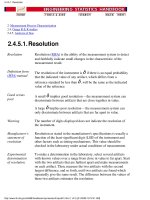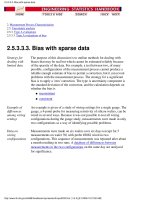Engineering Statistics Handbook Episode 4 Part 15 docx
Bạn đang xem bản rút gọn của tài liệu. Xem và tải ngay bản đầy đủ của tài liệu tại đây (88.76 KB, 12 trang )
3. Production Process Characterization
3.4. Data Analysis for PPC
3.4.2.Exploring Relationships
The first
analysis of
our data is
exploration
Once we have a data file created in the desired format, checked the
data integrity, and have estimated the summary statistics on the
response variables, the next step is to start exploring the data and to try
to understand the underlying structure. The most useful tools will be
various forms of the basic scatter plot and box plot.
These techniques will allow pairwise explorations for examining
relationships between any pair of response variables, any pair of
explanatory and response variables, or a response variable as a
function of any two explanatory variables. Beyond three dimensions
we are pretty much limited by our human frailties at visualization.
Graph
everything
that makes
sense
In this exploratory phase, the key is to graph everything that makes
sense to graph. These pictures will not only reveal any additional
quality problems with the data but will also reveal influential data
points and will guide the subsequent modeling activities.
Graph
responses,
then
explanatory
versus
response,
then
conditional
plots
The order that generally proves most effective for data analysis is to
first graph all of the responses against each other in a pairwise fashion.
Then we graph responses against the explanatory variables. This will
give an indication of the main factors that have an effect on response
variables. Finally, we graph response variables, conditioned on the
levels of explanatory factors. This is what reveals interactions between
explanatory variables. We will use nested boxplots and block plots to
visualize interactions.
3.4.2. Exploring Relationships
[5/1/2006 10:17:39 AM]
3.4.2.1. Response Correlations
(2 of 2) [5/1/2006 10:17:40 AM]
The second graph is a box plot of the number of large particles added for each cassette type.
3.4.2.2. Exploring Main Effects
(2 of 9) [5/1/2006 10:17:50 AM]
We conclude from these two box plots that cassette does not appear to be an important factor for
small or large particles.
There is a
difference
between
slots for
small
particles,
one slot is
different for
large
particles
We next generate box plots of small and large particles for the slot variable. First, the box plot for
small particles.
3.4.2.2. Exploring Main Effects
(3 of 9) [5/1/2006 10:17:50 AM]
Next, the box plot for large particles.
3.4.2.2. Exploring Main Effects
(4 of 9) [5/1/2006 10:17:50 AM]
We conclude that there is a difference between slots for small particles. We also conclude that one
slot appears to be different for large particles.
Load lock
may have a
slight effect
for small
and large
particles
We next generate box plots of small and large particles for the load lock variable. First, the box plot
for small particles.
3.4.2.2. Exploring Main Effects
(5 of 9) [5/1/2006 10:17:50 AM]
Next, the box plot for large particles.
3.4.2.2. Exploring Main Effects
(6 of 9) [5/1/2006 10:17:50 AM]
We conclude that there may be a slight effect for load lock for small and large particles.
For small
particles,
temperature
has a
strong
effect on
both
location
and spread.
For large
particles,
there may
be a slight
temperature
effect but
this may
just be due
to the
outliers
We next generate box plots of small and large particles for the temperature variable. First, the box
plot for small particles.
3.4.2.2. Exploring Main Effects
(7 of 9) [5/1/2006 10:17:50 AM]
Next, the box plot for large particles.
3.4.2.2. Exploring Main Effects
(8 of 9) [5/1/2006 10:17:50 AM]
'
We conclude that temperature has a strong effect on both location and spread for small particles. We
conclude that there might be a small temperature effect for large particles, but this may just be due to
outliers.
3.4.2.2. Exploring Main Effects
(9 of 9) [5/1/2006 10:17:50 AM]
We conclude from this plot that for small particles, the load lock effect is not as strong for high
temperature as it is for low temperature.
The same
may be true
for large
particles
but not as
strongly
The following is the box plot of large particles for load lock nested within temperature.
3.4.2.3. Exploring First Order Interactions
(2 of 3) [5/1/2006 10:17:53 AM]
We conclude from this plot that for large particles, the load lock effect may not be as strong for high
temperature as it is for low temperature. However, this effect is not as strong as it is for small
particles.
3.4.2.3. Exploring First Order Interactions
(3 of 3) [5/1/2006 10:17:53 AM]









